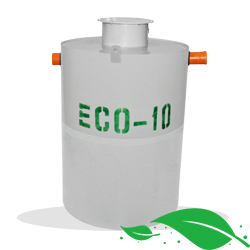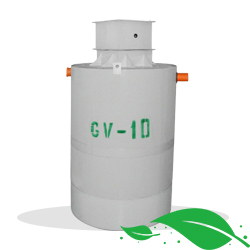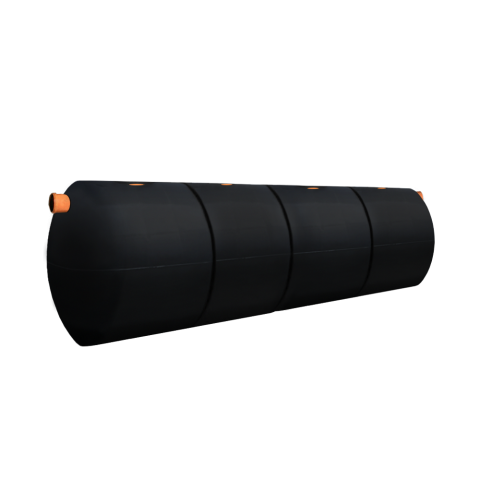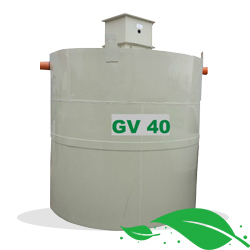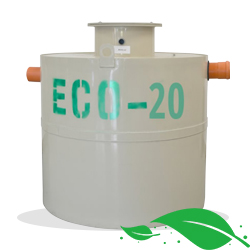

ECO 20 SEPTIC TANK
Cod produs: ECO20
7750 lei
Descriere produs
ECO septic tanks are primary anaerobic treatment units of wastewater from civil or industrial installations. They are widely used in the construction of new treatment plants or in the refurbishment of old plants, as they are pre-treatment sections useful for fluidising the leakage agent polluting load. The main feature of ECO septic tanks is that they naturally provide, without chemical treatment, the treatment of wastewater to the parameters stipulated by the legal regulations, depending on the number of users.
The biological septic tank is monoblock, has three rooms, with adjacent compartments, one for sedimentation, one for digestion and a third for final sedimentation.
The sedimentation compartment, physically separated from the digester, is connected to it only through the passageway from the extreme side of the sedimentation tank. The black water reaches the sedimentation tank, where, through the specific weight difference between the water and the sedimentary material, sedimentation occurs, that precipitates in the anaerobic digestion zone.
Sediment-free water passes through the outlet pipe, while sediments remain on the bottom of the tank and undergo an anaerobic digestion process, which partially mineralises the organic substance.
The septic tank will be regularly emptied by specialised firms.
THE FUNCTIONING PRINCIPLE OF THE SEPTIC TANK
Biological septic tanks are made of high-strength PP-C (polyethylene), fully recyclable. They consist of a main vat, called sedimentation tank, and a fermentation tank present in the sedimentation tank. The principle of functioning is anaerobic, with the decomposition and fermentation of the pollutants (faeces) from the domestic waters, through the bacteria formed in the absence of oxygen.
DESCRIPTION OF THE FUNCTIONING PROCESS
Wastewater enters through the fermentation tank where, under the action of anaerobic bacteria and based on the liquid-liquid/liquid-solid gravity separation laws, decomposition and separation of light and sedimentary matter occur. Following this separation process, the polluting sludge is deposited through the discharge slot into the sedimentation area, from where it is removed after a period by emptying.
The resulting treated water is discharged through communicating vessels into underground drains, from where they will be taken over by the capillary vessels of the soil that will continue to act as a biological filter.
The advantages of this solution are that the volume of waste that is emptied is very small, compared to the corresponding volume of the sedimentary deposit, because, through the action of anaerobic bacteria, it mineralises and loses its water content. After the fermentation processes, biogas is formed, which is evacuated into the atmosphere through the special hole created for it.
INSTALLATION
The site must meet the following requirements and conditions:
- to ensure the gravity flow of the water (compliance with the drainage slope);
- to be located outside the property at least 1 meter from the foundation and at least 10-15 meters from any source of drinking water;
- to ensure easy access for emptying;
- the soil must be adequately permeable as a treated water receiver (check by percolation test);
- in areas at risk of flooding it is recommended to build protective walls.
PRODUCT ADVANTAGES
- small
- tightly closed
- does not occupy space (must be buried)
- low weight
- does not require power supply
- does not require maintenance, just emptying
PERFORMANCES
Ecological septic tanks through wastewater treatment provide the following:
- removal of the organic sludge component up to 50%
- removal of sediments to up to 90%
- reduction of CBO5* (biochemical oxygen consumption) compared to effluent loading by up to 40%
| Biological septic tank | |
| Model | ECO20 |
| Number of users | 20-24 |
| Dimensions (cm) | |
| Overall height | 2150 |
| Vat height | 1950 |
| Inlet | 1850 |
| Outlet | 1800 |
| Diameter (cm) | |
| Vat (Ø) | 1500 |
| Inlet pipe (Øi) | 110 |
| Outlet pipe (Øe) | 110 |
| Manhole (Ø xh) | 500x200 |
| Biogas (Ø) | 1" |
| Volume (litres) | |
| Useful | 3260 |
| Total | 3440 |
Nici un comentariu pentru acest produs. Fii primul!
Adaugă un review
